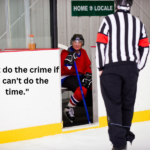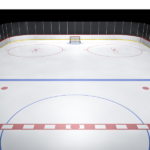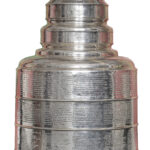Alright, so let’s talk about the penalty shot in hockey. Essentially, if a player on the opposing team commits a foul that deprives an opponent of a clear goal-scoring opportunity, then the fouled player is awarded a penalty shot. It’s just them and the goaltender, with no other players allowed within 60 feet of them until after the puck is touched or shot. The shooter has one chance to put the puck past the goalie and score.
It’s always pretty exciting to see who comes out on top in this high-pressure situation! The penalty shot is a unique aspect of hockey that can really change the course of a game in favor of one team or another!

When is a penalty shot awarded?
When a player is fouled from behind when on a breakaway. Usually by a hook or a trip.
If an object like a stick or glove is thrown by a defensive player to interrupt a clear breakaway.
If a player (other than the goalie), in the crease picks up or places his hand over the puck.
When a goaltender deliberately dislodges the net from it’s posts to prevent a clear on scoring chance.
The penalty shot is awarded in lieu of what would normally be a minor penalty. The fouled team does not get a power play and a penalty shot from the same infraction.
Famous Penalty Shots in Hockey History
Penalty shots in hockey have provided some of the most thrilling moments in the sport’s history. Here are three legendary examples:
1972 Summit Series
In the decisive eighth game of the 1972 Summit Series between Canada and the Soviet Union, Canadian Paul Henderson scored the game-winning goal in the final moments of the third period. But it was a penalty shot by Soviet star Valeri Kharlamov earlier in the game that set the stage. With Canada leading 4-2, Kharlamov was awarded a penalty shot after being tripped by Canadian defender Jocelyn Guevremont. Kharlamov deked Canadian goalie Ken Dryden with a fake shot before scoring with a backhand, cutting Canada’s lead to one and setting up the dramatic finish.
1994 Stanley Cup Finals
In Game 4 of the 1994 Stanley Cup Finals between the New York Rangers and the Vancouver Canucks, Rangers forward Stephane Matteau scored a double-overtime goal to give New York a 2-1 series lead. But earlier in the game, Canucks captain Trevor Linden was awarded a penalty shot with the score tied 1-1. Linden made a move to his forehand, but Rangers goalie Mike Richter made a sprawling save to keep the game tied. The save would prove crucial, as Matteau’s heroics would ultimately seal the Rangers’ first Cup victory in 54 years
2010 Olympic Gold Medal Game
In the gold medal game of the 2010 Winter Olympics in Vancouver, Team USA and Canada were tied 2-2 in the final minutes of regulation. With less than a minute remaining, American Zach Parise tied the game to force overtime. In the extra period, Canadian Sidney Crosby was awarded a penalty shot after being taken down by American defenseman Brian Rafalski. Crosby, one of the game’s all-time greats, skated in on American goalie Ryan Miller and beat him with a snipe to win the gold medal for Canada.
Impact of technology on penalty shots
Technology has also impacted penalty shots. In recent years, video review has been introduced to ensure that the correct call is made. This has led to instances where a penalty shot is awarded after a play is reviewed, even if it was not originally called on the ice.
As technology continues to advance, it will be interesting to see what other changes are in store for this exciting part of the game
Check Out This Video of Penalty Shots
In conclusion, the penalty shot is a thrilling aspect of hockey that can have a significant impact on the game’s outcome. Teams must be familiar with the rules and regulations governing penalty shots, while goalies and shooters must master techniques and strategies to increase their chances of success. With ever-evolving technology and changes in the sport, the future of the penalty shot remains exciting and uncertain. However, one thing is for sure: the penalty shot will continue to be an essential and entertaining part of hockey for players and fans alike
Thanks for your time. Please leave comments and suggestions below.




